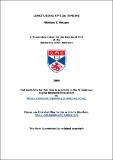Files in this item
Longitudinal optical binding
Item metadata
| dc.contributor.advisor | Dholakia, Kishan | |
| dc.contributor.author | Metzger, Nikolaus K. | |
| dc.coverage.spatial | 168 | en |
| dc.date.accessioned | 2008-07-11T13:11:03Z | |
| dc.date.available | 2008-07-11T13:11:03Z | |
| dc.date.issued | 2008-06-24 | |
| dc.identifier.uri | https://hdl.handle.net/10023/519 | |
| dc.description.abstract | Longitudinal optical binding refers to the light induced self organisation of micro particles in one dimension. In this thesis I will present experimental and theoretical studies of the separation between two dielectric spheres in a counter-propagating (CP) geometry. I will explore the bistable nature of the bound sphere separation and its dependency on the refractive index mismatch between the spheres and the host medium, with an emphasis on the fibre separation. The physical under pining principle of longitudinal optical binding in the Mie regime is the refocusing effect of the light field from one sphere to its nearest neighbour. In a second set of experiments I developed means to visualise the field intensity distribution responsible for optical binding using two-photon fluorescence imaging from fluorescein added to the host medium. The experimental intensity distributions are compared to theoretical predictions and provide an in situ method to observe the binding process in real time. This coupling via the refocused light fields between the spheres is in detailed investigated experimentally and theoretically, in particular I present data and analysis on the correlated behaviour of the micro spheres in the presence of noise. The measurement of the decay times of the correlation functions of the modes of the optically bound array provides a methodology for determining the optical restoring forces acting in optical binding. Interestingly micro devices can be initiated by means of the light-matter interaction. Light induced forces and torques are exerted on such micro-objects that are then driven by the optical gradient or scattering force. I have experimentally investigate how the driving light interacts with and diffracts from the motor, utilising two-photon imaging. The micromotor rotation rate dependence on the light field parameters is explored and theoretically modelled. The results presented will show that the model can be used to optimise the system geometry and the micromotor. | en |
| dc.format.extent | 25908563 bytes | |
| dc.format.mimetype | application/pdf | |
| dc.language.iso | en | en |
| dc.publisher | University of St Andrews | |
| dc.subject | Optical | en |
| dc.subject | Tweezers | en |
| dc.subject | Array | en |
| dc.subject | Binding | en |
| dc.subject | Nonlinear | en |
| dc.subject | System | en |
| dc.title | Longitudinal optical binding | en |
| dc.type | Thesis | en |
| dc.contributor.sponsor | EU NEST | en |
| dc.type.qualificationlevel | Doctoral | en |
| dc.type.qualificationname | PhD Doctor of Philosophy | en |
| dc.publisher.institution | The University of St Andrews | en |
This item appears in the following Collection(s)
Items in the St Andrews Research Repository are protected by copyright, with all rights reserved, unless otherwise indicated.

